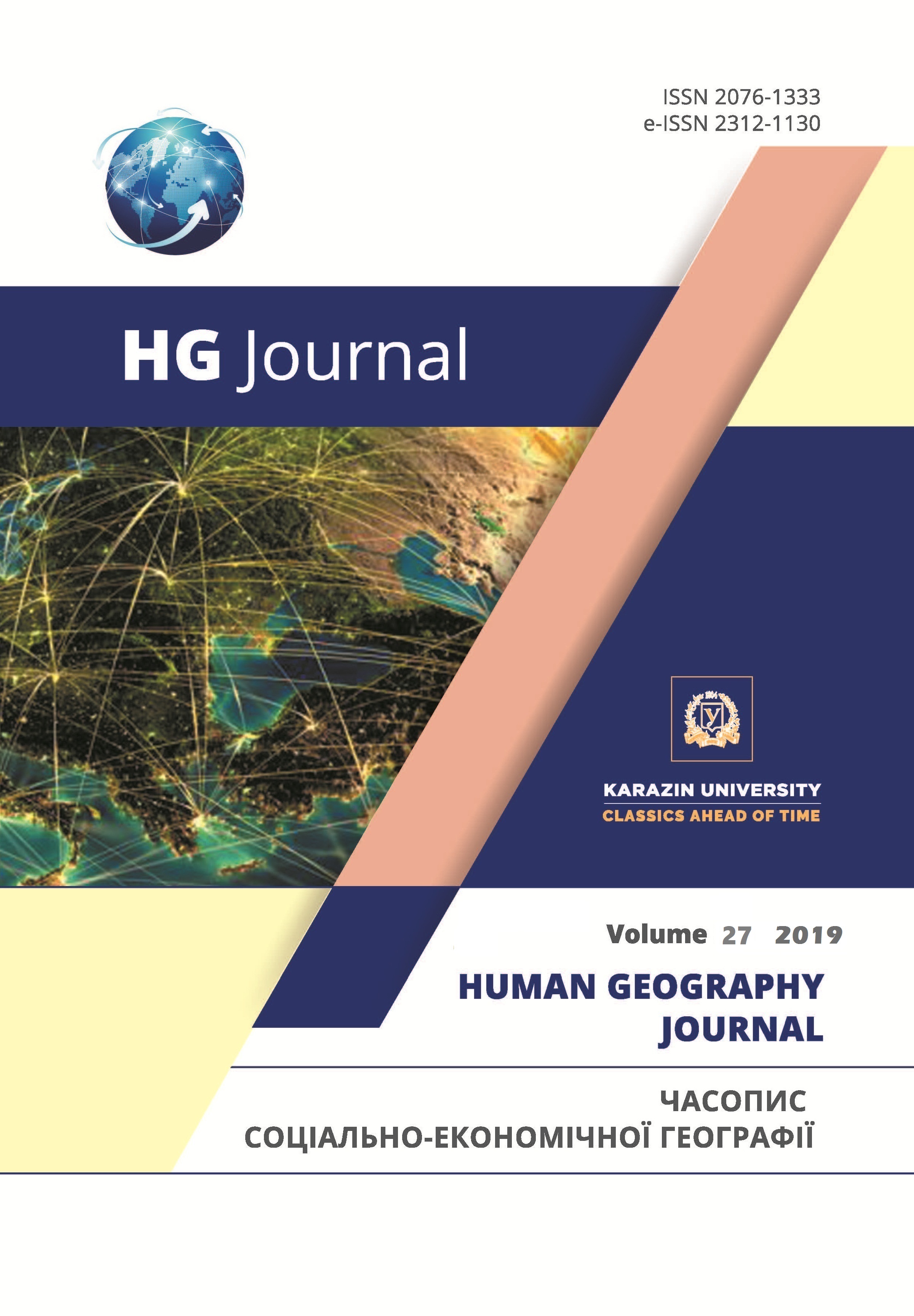The vulnerability of the peninsulas toward the manifestations of territorial-political conflicts
Abstract
In the early 21st century, conflicts remained widespread on the political map of the world. The article explores the role of the peninsula as a subject of territorial dispute, territorial expansion, as well as the region of arms deployment and battlefield. A significant challenge to the security of Ukraine and all of Central and Eastern Europe was the annexation of Crimea by Russia in 2014. Despite the popular in modern Political Geography discourse on the decline of traditional Geopolitics, the peninsulas still can be explored as vulnerable to manifestations of geopolitical and military rivalry.
The purpose of the article is to establish a list of peninsulas vulnerable to the manifestation of international territorial claims, disputes and conflicts, and on this basis to propose a classification of peninsular regions according to their position on the political map. The peninsula is a stretch of land that can be functionally used to establish military and civilian control of adjacent territories. Maintaining military bases on the peninsula makes sense to modern nations because of their role as outposts for the effective deployment of land, air, and naval components of the armed forces and their use inland, adjacent regions and airspace. The peninsulas became a battlefields during the so-called proxy wars that took place between the countries of the West and the East on the territory of third countries. The conquest and decolonization of the peninsula have given rise to specific forms of jurisdiction, such as the British Overseas Territory of Gibraltar, with its autonomous system of government within the United Kingdom, or the autonomous Hong Kong and Hong Kong. The large peninsulas are characterized by several historic cores of statehood, some of which may be located outside the state. This creates favorable conditions for regionalism and devolution (Lombardy in Italy), separatism (Catalonia in Spain), irredentism (Crimea, Bakassi) and armed conflicts (Somalia). The Russian annexation of the Crimean Peninsula is a flagrant violation of international law. De-occupation is the only acceptable solution to the problem, but the necessary prerequisites for changing the political regime and paradigm of the foreign policy of the Russian Federation must be ripe for this.
Downloads
References
Bagrov, N.V. (2002). Regionalnaya geopolitika ustoychivogo razvitiya [Regional Geopolitics of Sustainable Development]. Kiev, 256 [in Russian].
Bzhezynskyi, Z. (2000). Velyka shakhivnytsia. Amerykanske panuvannya ta yoho geostratehichni imperatyvy [Great chessboard. American domination and its geostrategic imperatives]. Lviv, Ivano-Frankivsk: Lileia-NV, 236 [in Ukrainian].
Vinokurov, E.Yu. (2007). Teoriya anklavov [Enclave Theory]. Kaliningrad, 342 [in Russian].
Vortman, D.Ya. Perekopski riv i val [Perekop ditch and shaft]. Entsyklopediya istorii Ukrainy – Encyclopedia of the History of Ukraine. Retrieved from: http://www.history.org.ua/?termin=Perekopskyj_riv [in Ukrainian].
Нaiduk, S. (2018). Stratehichnyi maydanchyk Rosii v Ukraini: kudy dyvytsya vlada? [Russia's strategic platform in Ukraine: where does the goverment look?]. Obozrevatel – Reviewer. Retrieved from: https://www.obozrevatel.com/ukr/politics/strategichnij-majdanchik-rosii-v-ukraini-kudi-divitsya-vlada.htm [in Ukrainian].
Goryunova, E. (2019). Rejtingovye poteri Kryma: kogda rossijskie dotatsii ne spasayut [Rating losses of Crimea: when Russian subsidies do not save]. Krym. Realii. – Crimea. Realities. Retrieved from: https://ru.krymr.com/a/rejtingovye-poteri-kryma-kogda-rossijskie-dotatsyi-ne-spasaut/29982282.html [in Russian].
Dnistryanskyi, M.S. (2014). Politychna geografiya Ukrainy [Political geography of Ukraine]. Lviv: LNU imeni Ivana Franka, 348 [in Ukrainian].
Gorbulin, V.P., Vlasyuk, O.S., Libanova, E.M., & Lyashenko, O.M. (2015). Donbas i Krym: tsina povernennya [Donbas and Crimea: return at what price?]. Kyiv: NISD, 474 [in Ukrainian].
Ezhegodnik SIPRI 2016: vooruzheniya, razoruzhenie i mezhdunarodnaya bezopasnost. [SIPRI Yearbook 2016: Arms, Disarmament and International Security]. M.: IMEMO RAN, 1044 [in Russian].
Zadorozhnyi, O. (2015). Aneksiya Krymu – mizhnarodnyi zlochyn [Annexation of Crimea – International Crime]. К.: Yuri Marchenko, 576 [in Ukrainian].
Kissinger, H. (2018). Svitovyi poryadok. Rozdumy pro kharakter natsii v istorychnomu konteksti [World order. Reflections on the character of nations and the course of history]. (N. Koval. Trans). K.: Nash format, 320 [in Ukrainian].
Popov, F.A. (2012). Geografiya setsessionizma v sovremennom mire [Geography of secessionism in the modern World]. M.: Novyi khronograf, 672 [in Russian].
Yatsenko, B.P., Stafiychuk, V.I., Braychevskyi, Yu.C., et. al. (2007). Politychna geografiya i geopolityka [Political geography and geopolitics]. K.: Lybid, 255 [in Ukrainian].
Baczwarow, M., Suliborski, A. (2003). Kompendium wiedzy geografii politycznej i geopolityce. Terminologia. Warszawa: Wydawnictwo Naukowe PWN, 190 [in Polish].
Baye, F.M. (2010). Implications of the Bakassi conflict resolution for Cameroon. African Journal on Conflict Resolution, 10, 9-34.
Collins, J.M. (1998). Military Geography for professionals and public. Washington, DC, National Defense University Press.
Conflict Database (2018). Conflict Barometer. Retrieved from: https://hiik.de/data-and-maps/conflict-database/?lang=en
Data Sets (2019). Correlate of War Project. Retrieved from: http://www.correlatesofwar.org/data-sets
Mountz, A. (2015). Political geography II: Islands and archipelagos. Progress in Human Geography, 5, 636-646.
Multinational Force and Observers. Retrieved from: https://en.wikipedia.org/wiki/Multinational_Force_and_ Observers
Rey, V., Groza, O. (2009). Balkans. International Encyclopedia of Human Geography. Editors-in-Chief R. Kitchin and N. Thrift. Amsterdam: Elsevier, 1, 265-272.
Slyvka, R. (2017). The preconditions for conflicts in Donbas and Crimea: similar and diverse features. Minorities in the borderlands and on the fringes of countries. Еdited by M. Sobczyński and M. Barwiński. Łódż. (Region and Regionalism), 13(1), 187-224.
World Factbook (2019). CIS. Retrieved from: https://www.cia.gov/library/publications/the-world-factbook/.
Copyright (c) 2019 Сливка Р.

This work is licensed under a Creative Commons Attribution 4.0 International License.




